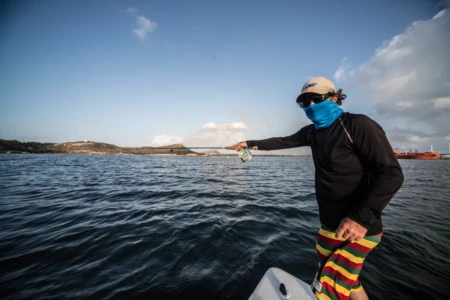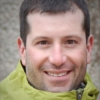Curacao’s Big Oil and Big Tarpon
“Fish, two o’clock,” shouted Norman Chumaceiro, my guide to tarpon on the idyllic island of Curacao, 40 miles off the coast of Venezuela. “Now they’re at nine! And six. They’re everywhere!” he exclaimed.
If anyone could help me come tight on a tarpon it’s Chumaceiro, who, along with his friend Albert Macares, are the only tarpon fishermen on the island. They spend most weekends angling for the king in the Schottegat harbor, just east of the Santa Anna Bay, where luxury cruise liners amble in and out, unloading thousands of tourists to the island every day to shop the strip of waterfront, candy-colored Dutch-style buildings. As I cast feverously to the rolling fish, hundreds of them, I couldn’t help but to notice that this harbor, while thronged with more tarpon than I’ve ever before seen, was coated with a thin slick of oil.
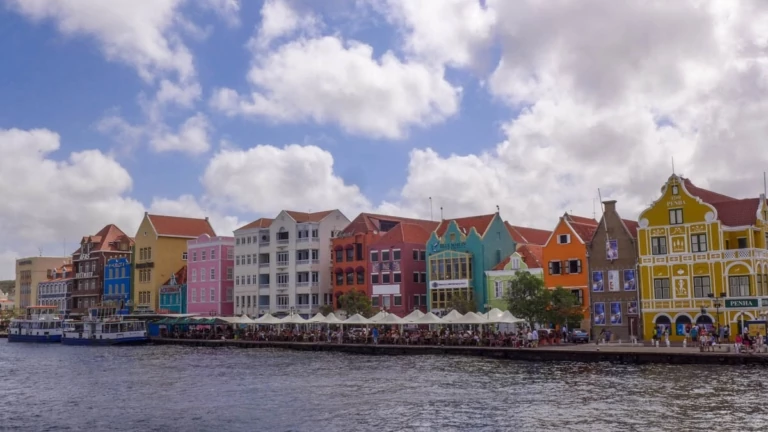
Willemstad, Curacao is a UNESCO World Heritage site. These colorful buildings have stood since the 1700s and are constructed of coral. Photo: Brian Irwin
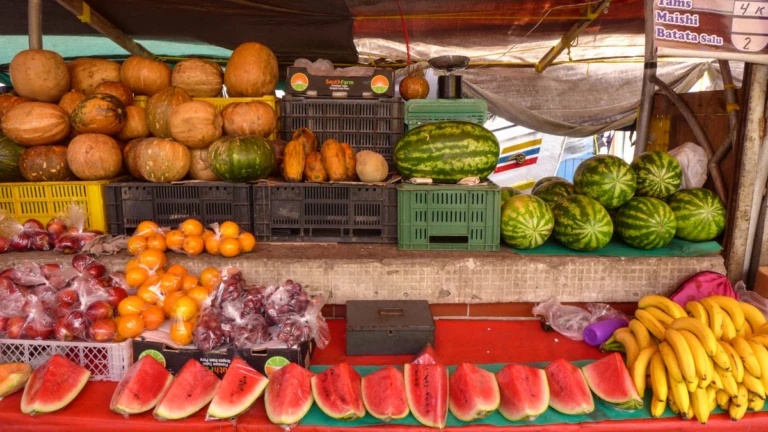
There’s little produce native to Curacao, as its hills are arid. Most of the produce comes from Venezuela, 40 miles away, and is sold directly out of boat in the “floating market.” Photo: Brian Irwin
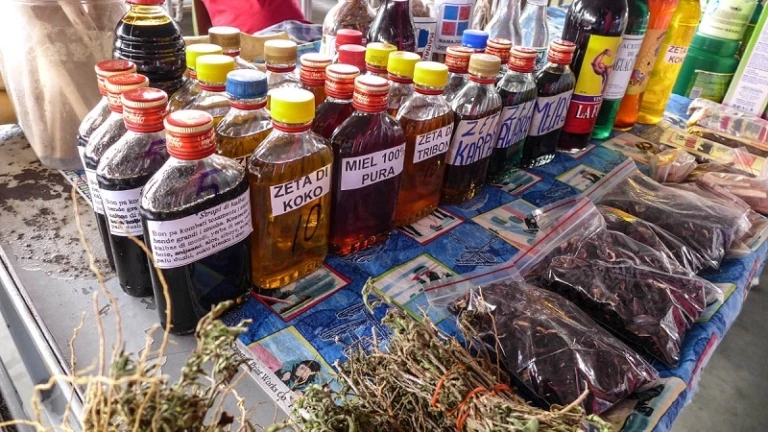
Fresh goods from Venezuela are on sale at Curacao’s open market. Photo: Brian Irwin
The environmental impact of the refinery had fallen under intense scrutiny as evidence mounted that direct accidental oil and waste discharges were commonplace at the refinery. One harbinger of what was to come was the evolution of “asphalt lake,” a bay whereby discarded fuel and waste into the water literally congealed into asphalt, a firm patch of disgust that exists today, despite cleanup efforts.
In 1985, Shell “gifted” the refinery to the country of Curacao for the symbolic price of four Netherlands Antillean Guilders, around two USD. The government promptly turned the keys over to PDVSA, who continues to operate the industrial area today. Since, numerous reports and environmental studies have shown ongoing pollution far in excess of the standards held by the Dutch, who have final authority over what happens in this nearly autonomous country. For example, in 1992 the Dutch Ministry of Transport, Public Works and Water management stated that “the refinery was saturated with crude oil, petroleum products and impurities.” Another 2001 study by the Environmental service of Curacao reported that the refinery spit out unacceptably high levels of sulfur dioxide, and that around eight thousand downwind residents were exposed to such air pollution every day.
But the tarpon are there in droves. We’d find schools of hundreds, many schools, on each of the two days we went out. And although we were sharing our angling water with enormous container ships and oil-toting boats, we were the only fisherman.
“It’s always like that out here,” Chumaceiro reported. “Albert and I are the only people who fish for tarpon on this island. We use bait but always throw them back. The locals think we’re crazy.”
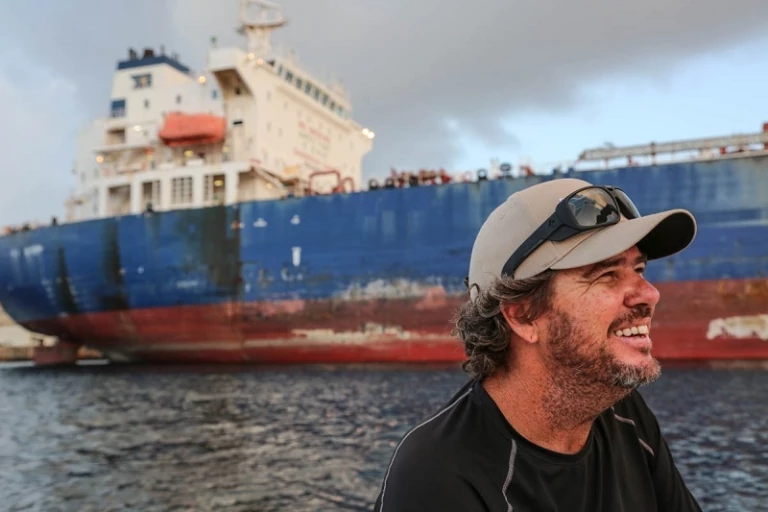
Big tarpon, big oil. Chumaceiro grins at the favorable conditions as a container ship creeps past us in the Shottegat Harbor. Photo: Brian Irwin
I came to Curacao based on a single online report of tarpon being pulled from the Schottegat. I came to fly fish, something that the islanders had never seen before. Curacao isn’t a fly fishing destination, or at least yet, partly due to the reality of the fisheries and their water quality, partly due to the lack of exposure, and I postulate, partly due to the consistently high winds.
One can easily understand why no one wants to fish in a polluted harbor, however the interesting observation I made was that there were no tarpon elsewhere on the island. Curacao is a striking place. Its some 35 beaches are carved out of jagged coral cliffs and hold gin-clear, aquamarine water. Just to the south of Willemstad, a bustling town rife with the cultural fusion of Spanish, Jewish, Dutch and English, rests the Spanish Waters, a picturesque bay full of mangrove islands, grassy flats and deep channels. It’s here where Chumaceiro was raised.
“The Spanish Waters used to be my own nature park. We used to handline for snapper and barracuda, every day. When I grew up there we were the only house in the bay,” Chumaceiro recalled. “Today it’s different, but I like the change.”
The Spanish Waters is indeed different from what Chumaceiro knew as a young boy. Today it is the playpen of the rich, with mega yachts dangling from their moorings and svelte topless European sunbathers on the docks of large homes. However, it still holds a thick population of barracuda, which we caught on my last day on Curacao. However, despite the perfect conditions and abundance of small baitfish, the tarpon were absent.
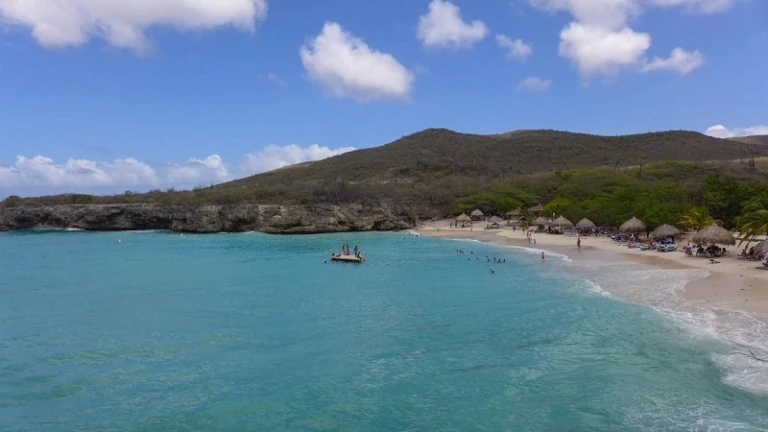
Curacao has some 35 idyllic beaches and some of the best diving in the Caribbean. But these coves are without any significant tarpon presence. Photo: Brian Irwin
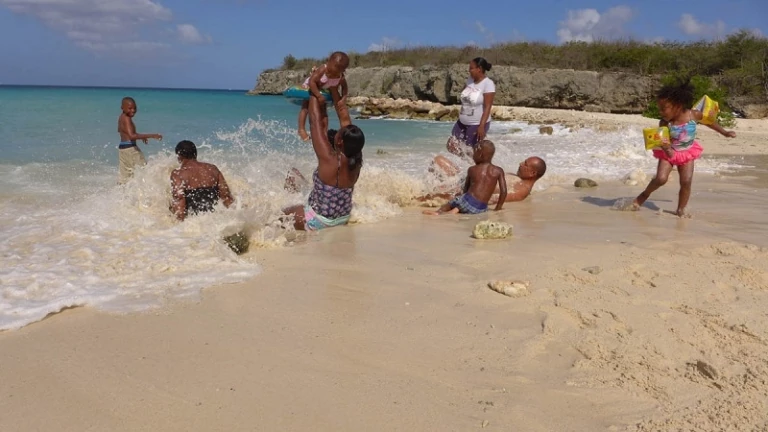
A family splashes in the surf at one of Curacao’s many beaches. The diverse construct of Curacao’s ethnic fabric makes it one of the most interesting parts of the country. Photo: Brian Irwin
Andy Danylchuk, PhD is a revered fish biologist at the University of Massachusetts Amherst. An ardent fly angler and Patagonia ambassador, Danylchuk weighed in on why tarpon would favor a polluted bay. “Tarpon might have been there long before the refinery because the bay is sheltered and there could be a high availability of prey,” Danylchuk explained.
This made sense, as there was an abundance of huge mullet in the bay, likely the food of choice for the kings. He went on to hypothesize “…that nutrient input resulting from the broader activities associated with the refinery are causing enrichment of coastal waters. This nutrient enrichment is likely fueling the food web by promoting the growth of algae, which, in turn means more zooplankton, then more baitfish, and then potentially tarpon.”
That said, more algae isn’t necessarily better. Blooms deplete the oxygen tension in the water and eventually are quite harmful to the ecosystem. So ironic it is that the slow environmental degradation of the harbor may produce a bounty of tarpon, but only do so by injuring the ecosystem as a whole.
Danylchuk has experience in fish toxicology and went on to explain the impact of environmental contaminants on tarpon.
“Contaminants such as mercury can be a neurotoxin that affects motor control… [Mercury is] now being shown to be [an] endocrine disrupting compound, so mimicking hormones. This can result in changes in triggers for feeding, reproduction, ultimately resulting in declines in population.”
In collaboration with Bonefish & Tarpon Trust and Florida Fish and Wildlife, Danylchuk has agreed to help analyze the situation in Curacao by studying scale samples of tarpon harvested from the Schottegat. Generously, Macares and Chumaceiro have been spending time fishing for tarpon and harvesting scales to send for analysis. With these specimens, Danylchuk will “determine how isolated this population is from other populations of tarpon in the Western Hemisphere.” He went on to explain this could be the link to why tarpon are in the harbor.
“If they are not isolated, meaning that there is a regular gene flow [into the population], then this could explain why the population persists in spite of the pollution (more fish entering the population than taken away by the impacts of the contaminants).”
“So why would beautiful water like the Spanish Waters lack tarpon?” I asked.
Danylchuk replied, “It could be just a matter of where larval tarpon settle and the preferred habitat as they grow. The bay currently occupied by tarpon may have sufficient fresh water input that can trigger larval settlement, while others do not. Subtle differences are all it might take to result in tarpon residing in one area while not residing in another.”
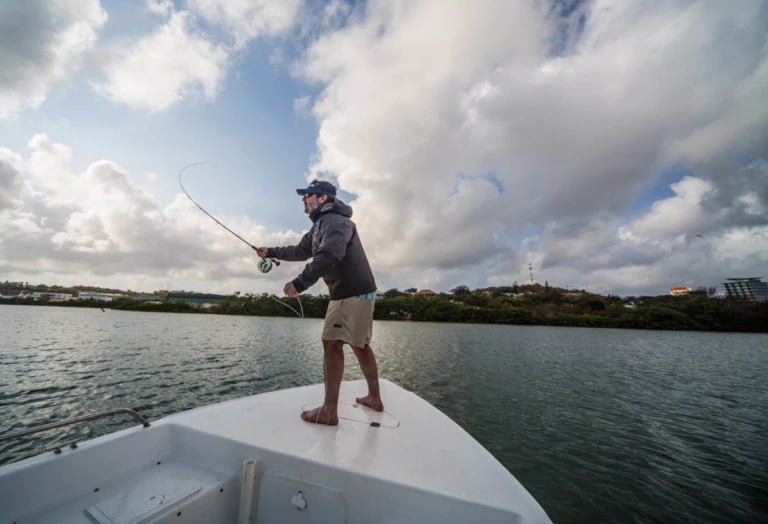
The author flips flies to selective tarpon rolling in the Shottegat Harbor. Photo: Brian Irwin Collection
Macares and Chumaceiro have been fishing together for decades. Although Macares was born in Holland he’s spent most of his life on Curacao, and he’s been fishing since his early years. They’re a dynamic pair who play off of each other. Soft jabs and raucous laughing sessions ping back and forth in their native unofficial language of Papiamento, a fusion of various languages including Dutch, Spanish and English.
Macares, 44, strikes a resemblance to a much more fit George Foreman. Chumaceiro, 46, has bushy hair and is a reggae fanatic, exhibited by the series of tattoos on his leg. A portrait of Bob Marley adjacent one of Ghandi adjacent one of Che Guevara ring his calf, flirting with his Rasta-colored board shorts as he threads blue runners for bait while Macares pilots his 19-foot Sea Fox around the harbor. Chumaceiro’s Great Great Great Grandfather was the first rabbi on the island back in 1860, and although he isn’t a practicing Jew, it comprises a portion of his multinational genetic fabric.
The morning of the last day I fished with these men we pulled up by the light of a falling full moon in the center of Willemstad. Macares lashed up the boat and flipped a concoction of sardines and tomato sauce into the harbor. Within a few minutes the slurry cloud in the water was infiltrated with six-inch baitfish. Macares wound up his pipes and heaved a net into the water, coming up with a few small fish. Behind him the “floating market” prepared for the day, its series of Venezuelan boats stacking produce and fish and cheese brought from the mainland. The floating market is a lifeblood for many Curacao locals, as Curacao is an arid place with little flora aside from cactuses and sagebrush.
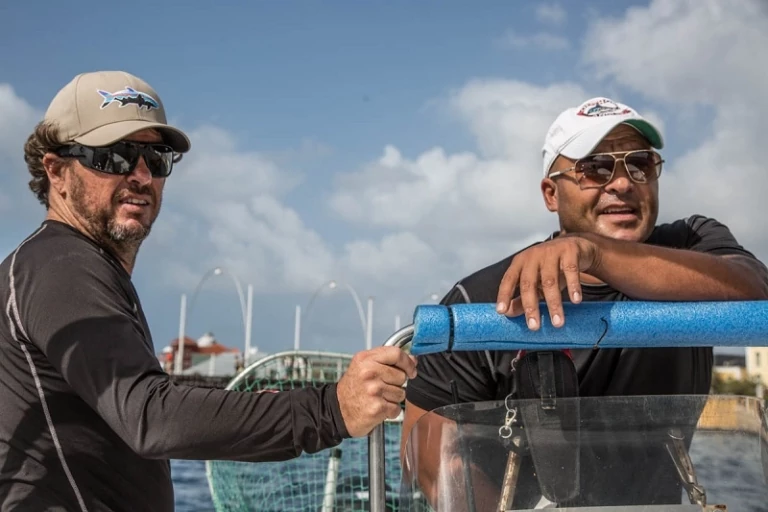
Norman Chumaceiro and Albert Macares are the only two tarpon fishermen on the entire island of Curacao. They primarily angle in the Shottegat Harbor, where a robust population of tarpon reside, despite turbid water and polluted water conditions. Photo: Brian Irwin
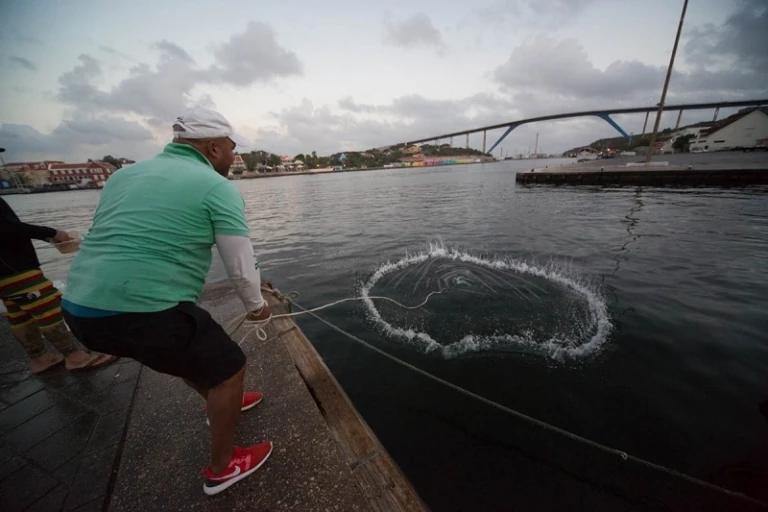
Albert Macares casts for baitfish in the Santa Anna Bay, Curacao. He’s a bait fisherman, but still adheres to a strict catch and release ethic. Photo: Brian Irwin
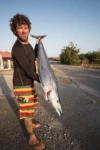
Chumaceiro holds a wahoo that was plucked from the sea by his friends. Offshore bluewater angling is the more popular form of fishing on the island, but Chumaceiro and Macares prefer to stick inside and fish for tarpon. Photo: Brian Irwin
We headed to the harbor where enormous tugboats ferried creaking, dripping steel monoliths of ships around the harbor. Giant cranes towered over the water; running bilge pumps from cargo ships spouted water forcefully into the polluted salt. The ships had come from all over the world. Singapore. Croatia. The Netherlands. These ships bring everything that the island needs, but unfortunately they operate aside oil tankers whose history of sanity is less than perfect.
“You gonna get the big one,” Chumaceiro piped up, lighting a damp cigarette in the salty air. He ashed into the harbor. Macares spoke up. “Careful Norman, this whole harbor might blow the hell up if you keep that up!”
We motored around for an hour, scanning the dark water for silver flashes. As we approached a series of pilings a broad chrome shoulder appeared, then another, then another. I cast in the brisk wind, pumping and double hauling to reach the fish. My tarpon toad laced through the water. Oil accumulated on my fingertips as I stripped. And then, with an explosion on the surface, my line came tight. I screwed up the set due to slack in the strong current. The fish erupted, and was gone.
Macares coached. “When it bites pull on that line like you’re trying to rip his damn face off!” And so when I hooked up only minutes later, I did just that. But alas, the fish ran, fought, jumped and threw the hook. I’d leave Curacao that next day tarponless.
As the sun set we retired to Macares’ home where Jim Beam closed the evening on a meal of calamari and shrimp paella at Macare’s swim up bar. He explained that there is a movement, albeit one that is still grassroots, to relocate the refinery and turn the entire area into a beautified resort area known as Greentown.
“They can clean up the harbor, it’d be nice,” Chumaceiro said. “But things may be different. It could affect life as we know it.” As I watched his words, a parrot on a post behind him, I realized that he wasn’t referring to loss of jobs.
“The tarpon are there for us, and we embrace them for sport,” he said. “If the water’s clean, the place would be so much nicer. But would we still be able to catch tarpon? The fishing may turn for the worse. But I’d be more than willing to find out the hard way.”
